Dork Rituals: The Pauper Project #5
Meta
Gattison
15 March 2018
1400 views
Dork Rituals: The Pauper Project
15 March 2018
1400 views
Dork Rituals: The Pauper Project
Issue 5: Finding Common Ground
Hello fellow TappedOut.users, welcome back to Dork Rituals: The Pauper Project. My name is still Gattison, I still maintain the Obscure List of Obscure Lists, I still write theme songs for Magic decks, and I still like Goblins too much. I'm on a mission to brew 32+ different paper pauper decks, one of each color combination (including 4-color & colorless), and I want your attention while I do.
So--while I have your attention--let me ask you a question. How much do the lands for your best decks typically cost? In other words, if I loved your deck, and wanted to buy the cards and build and play it myself, how much would I have to spend on lands alone? Ok, and what if we "optimized" the land base? You know, to be... ::raises pinky finger to pursed lips:: ...Tier 1 competitive? How much would they cost then?
Did you just get sick a little bit? Sorry.
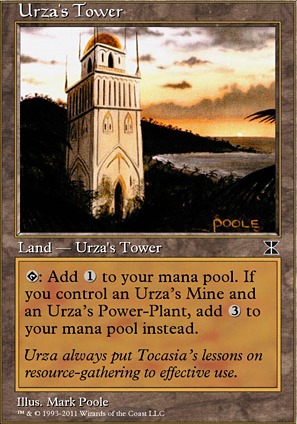
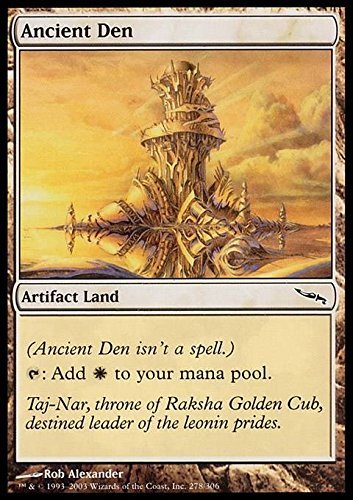
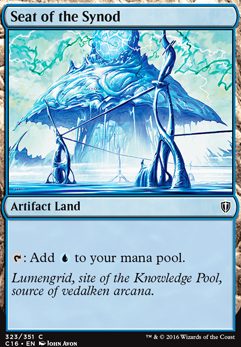
Maybe this will help you feel better. The most expensive lands in pauper can be found for less than $9 (US) at the time I write this. The Tron lands (Urza's Mine, Urza's Power Plant & Urza's Tower) and one of the artifact lands (Ancient Den) used to be the most expensive lands in pauper. In the past few months, with the rise in popularity of pauper, and the printing of Ash Barrens, this is no longer the case. Seat of the Synod and the new Ash Barrens have graduated to the upper leagues, meaning they cost more than a buck and change now. The former is now over $2 (US) and the latter is now around $8. Every other land weighs in at less than $2, and most are about a quarter (25 cents) or less. There's another reason to play pauper--on MTGO or in paper. Altogether, one of every land would cost you roughly $30-$35, meaning for about $120-$140 you can get a full playset of every single land in pauper. Not that anyone should--or shouldn't--because for that amount you can buy a playset of The Scarab Gods, or four Chandra, Torch of Defiances, but you see my point.
Compared to a format like Modern, there just aren't a ton of options for spicing up your landbase in pauper. Or are there? Sometimes, in pauper it is actually better to ignore all that distracting tech and just throw a bunch of basics in your deck and go play. But that's no fun to talk about, so let's instead take a tour through the commonlands and see what we can find.
First, the artifact lands of Mirrodin... again. But you've been here before with me, in Dork Rituals #3. This is just a familiar meeting place for us all to gather at before we board the bus. I feel there's not much more to say about them other to than to remind you they basically pay for when casting cards with Affinity for Artifacts cards, because they reduce the casting cost by and then can still for also. They can be used to more easily "activate" cards like Hunger of the Nim and Rusted Relic, and then let's not forget that cards like Galvanic Blast and Mirran Mettle exist. ...Around like issue 20 or so of Dork Rituals I'm going to go back, cut & paste everything I ever wrote about artifact lands, mash it all up and re-release it as a standalone article on artifact lands. See if anybody notices. =P
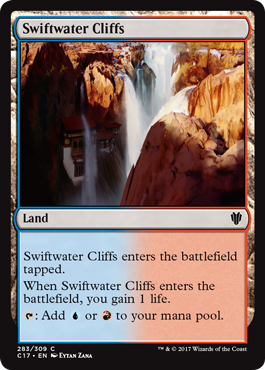
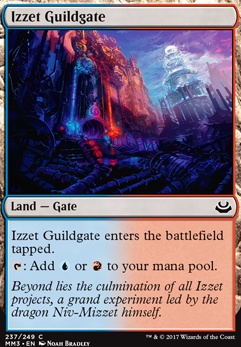
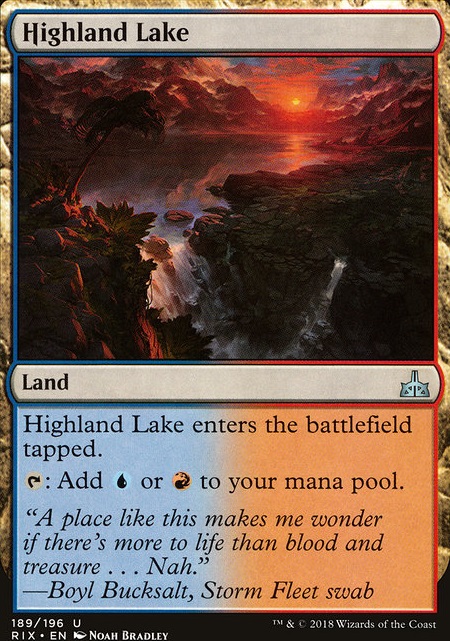
The first real stop on our tour is the Plane of Tarkir, where we'll take some time to stand on ten different "lifelands," or "gainlands." These lands are pretty much all-stars here in pauper, appearing as auto-includes in many multi-colored decks. They're strictly better than Gates and the cycle of dual-colored lands printed (as Uncommons) in Oath of the Gatewatch and again (as Commons) in Amonkhet block and Rivals of Ixalan because they gain you 1 life when they ETB--and gaining one life is better than not gaining one life... most of the time. They are the go-to lands in multi-color decks because all dual-lands in pauper enter the battlefield tapped, so they typically end up being the best choice from among the options given. By playing one or more of these lands in a game, you're essentially playing with 21+ life points, which can be the buffer you need, allowing to keep playing after receiving the traditional 20 damage. As a side note, there doesn't seem to be many combos you can go for with lifegain in pauper (Kalastria Nightwatch, Nirkana Assassin... and that's it according to a quick search of Gatherer), so it's not about the synergy, it's about the utility.
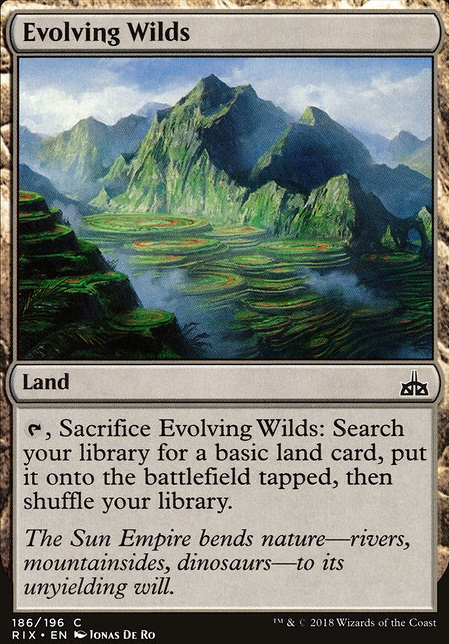
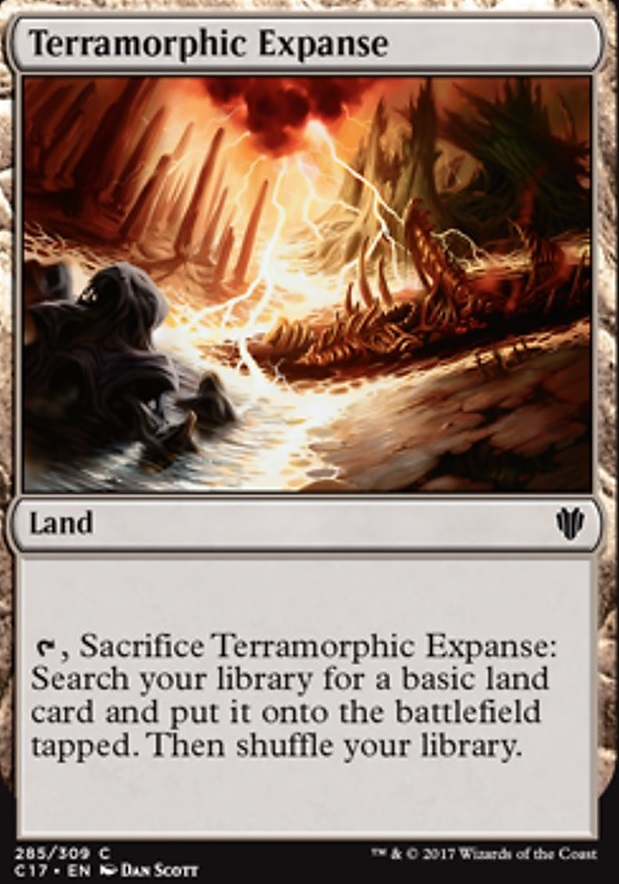
Next, we'll take a shortcut through a quantum asteroid field on our way to Innistrad and Alara. Ash Barrens, Evolving Wilds, Terramorphic Expanse, Warped Landscape and other pauper fetches, like the Panorama cycle, basically go to EDH/Commander decks to die after they rotate out of Standard--except for Evolving Wilds, which simply never rotates out--but here in pauper they're great for adjusting your landbase, or even thinning your deck, if you're into that.
You'll see Evolving Wilds all over the place in pauper, and sometimes Terramorphic Expanse will be acting as Evolving Wilds 5-8. Or Evolving Wilds #2 in Pauper EDH. I'll be honest. I used to make fun of this card. I used to talk down to it. "Trash," I would say. "What a garbage card. Who even cares that you exist, except for a budget Landfall player. Stupid Evolving Wilds." And then I would laugh and walk away feeling better about myself. And then Terramorphic Expanse? A functional reprint of a card that I basically read as, "Wait until next turn for your free land play." Come on. I wouldn't even look at a Terramorphic Expanse, upon a time. Now when I see them I apologize and put them with the other fifty copies I have, where it can be reunited with its brothers and sisters and cousins.
Evolving Wilds is important in Pauper. It's our "fetchland." It's the most accessible card that you can probably get for free from a friend or fellow gamer if you need to adjust your land base during a Pauper game. Three color decks need this card, as do most Pauper EDH decks. It doesn't matter that Ash Barrens exists now--and I'll talk more on that soon--because this card is everywhere. More likely than not, you will use this "crap" card in Pauper. And you will love it.
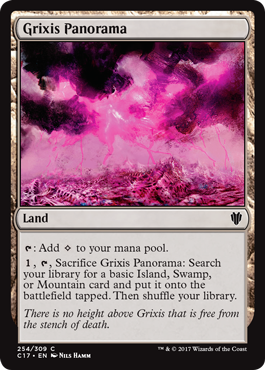
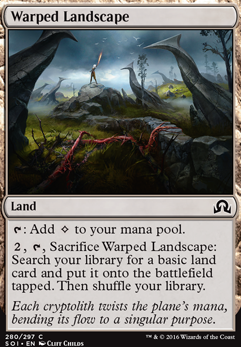
You will notice the obvious downside to Evolving Wilds and Terramorphic Expanse right away though. They, themselves, do not tap for mana. So, as the Wilds Evolve and Expand Terramorphically around us, we slip back into the Blind Eternities and make our way to Alara, to see what we can do about that. Here, we find the Panoramas. This cycle of lands enters the battlefield untapped and can be used to add to your mana pool--or just "add ," I guess, now--without having to wait a turn. This also means you can pay , and -sac' right away to go fetch one of three specified lands. The lands specified are based on the "shards," meaning there are no Panoramas for the "wedges," Abzan, Jeskai, Sultai, Mardu or Temur colors. I do want to point out one more thing before I move on though, and that is that since there are no mana symbols on the Panoramas, they have no color identity, and thus can be put in any Pauper EDH deck, even mono-colored ones.
But it doesn't end there for fetches though, so through the Blind Eternities we go, landing on the Warped Landscape of Innistrad. This land sees less play because it costs to fetch a land, but it lacks the restrictions of the Panoramas, so that is going to cost you. For an extra mana you can find any basic land. And again, if you start playing Pauper EDH, you're probably going to want to know about this card, too. Additionally, it was printed recently, so should be easier to find than the Panoramas, and at the very least can be a decent placeholder.
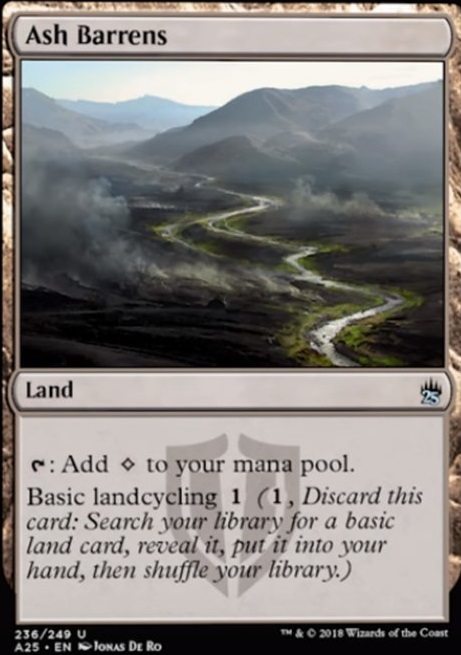
Last, but certainly not least, Ash Barrens is starting to take over, and it seems like every Pauper player wants to switch their Evolving Wilds over to this card. Evolving Wilds is becoming Ash Barrens #5-8. Having a seven or eight dollar price tag for the past few months is probably holding it back a bit from truly taking off, but the upcoming reprint in Masters 25 should help some. Coming back as an Uncommon will probably ensure it retains a value at least a few dollars once release-hype dies down, though. However, its utility is similar to Evolving Wilds, but different enough that it can be taken advantage of in new ways. In fact, I find the similarities and differences between Ash Barrens and Evolving Wilds pretty fascinating.
Let's consider the impact of playing an Evolving Wilds versus an Ash Barrens for a moment, shall we? (Especially since I've seen others ask this question, I've asked this question myself, and others have asked me this question.) Let's look at Evolving Wilds first, and let's say you use your land play and play the card on Turn One. As a result, on your first turn, you no longer have any mana to spend. Instead, you have a guaranteed way to fix your mana before your second turn. The tapped land that you fetched untaps during your Untap Step, you make your land play--boom. You're in control. In a three-color deck, this could be a potential way to guarantee you have your "rainbow" (all three colors in your deck) of lands out as early as possible. Or maybe you just really like triggering Bloodbriar.
Now let's look at a Turn One Ash Barrens. You play it... and you can tap for . Boring. What else does it do? Well, it only Basic Friggin' Landcycles! So, besides playing Ash Barrens as a mere land card, you can do something else with it before your second turn. You can play any other (mana-producing) land on Turn One, leave the mana up (untapped) as either a bluffing deterrent or to use to cast an actual response, and before the end of your opponent's turn, cycle your Ash Barrens. Then on Turn Two, you play that land. Now, just like with Evolving Wilds, by Turn Two you had more control over your land plays. The difference here is, with Ash Barrens you achieve that effect and can have emergency access to mana on Turn One.
Evolving Wilds, once you get it out of your hand, keeps things out of your hand. By this, I basically mean to say you'll trigger Landfall twice--the land you fetch goes right back onto the battlefield, but it enters tapped. You cannot use it right away. With Ash Barrens, once you cycle it, and fetch a basic land, you still have to get it out of your hand. That may sound like a downside to the card, but it's actually another of its benefits. That land that you cycled for before the end of your opponent's turn can now be played untapped as your land play on your turn.
In both cases, by turn two, you can have two untapped lands available to you. In both cases you are filling your graveyard, feeding things like Threshold and Delve. Evolving Wilds will trigger Revolt... sooooo, like... Countless Gears Renegade, anybody? Oh, and the aforemention Bloodbriar! Meanwhile, Ash Barrens will trigger Horror of the Broken Lands and the handful of other things like it. So once again, only slightly better, but Ash Barrens shows promise of far more versatility.
Such as this. Let's say it's mid-game and you need another color of mana now, and you have an Evolving Wilds and an Ash Barrens in hand. You could use your land play to put the Evolving Wilds out, but that means you have to wait until your next turn to use that mana. Instead, you can Basic Landcycle the Ash Barrens, get the land you need, and use your land play to put that out, to be used immediately if desired.
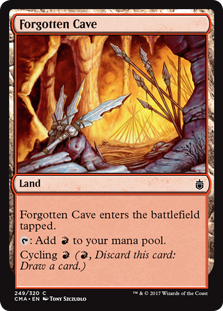
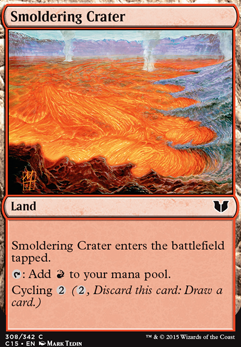
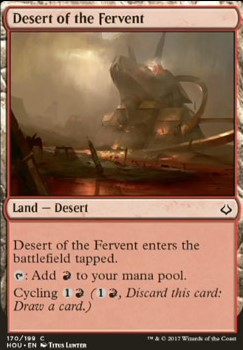
That's about all I have on that for now, but--speaking of Cycling--if you'll look out the windows on your right, you'll see the Planes of Dominaria and Amonkhet. Here, we'll take bathroom breaks on pauper's Cycling lands. Not a cycle of lands, but lands that Cycle. Fifteen different mono-colored lands that enter tapped, but can be cycled, meaning you pay, discard it from your hand, then draw a new card. Five released in Urza's Saga (Drifting Meadow, Polluted Mire, Remote Isle, Slippery Karst and Smoldering Crater). Five originally printed in Onslaught (Barren Moor, Forgotten Cave, Lonely Sandbar, Secluded Steppe and Tranquil Thicket). And now, thanks to the recently released Hour of Devestation set, five cycling Deserts also (Desert of the Fervent, Desert of the Glorified, Desert of the Indomitable, Desert of the Mindful and Desert of the True). I still prefer the original ten--the ones from Onslaught and Urza's Saga--but it's nice to have options, right?
These lands are nice when you need some extra draw power in your deck. Most of the time you can spend the mana and cycle it rather than play it, but in a pinch, you can still use it as a land. Mono-colored decks love the Onslaught because they're so cheap, in terms of mana. Then the Deserts can act as copies 5-8. Multi-colored decks might start looking towards the Urza's cycle because of the noncommittal that it costs to cycle them--it doesn't care what you have, you can cycle for what you need without color restriction.
On your left now are the Ravnican "Karoos," or bouncelands--such as those seen above--which see a lot of use, and are some of my personal favorites even though they aren't the best option for just any deck. Bouncelands can be useful in all sorts of ways, but at price. They can return utility lands, like Sandstone Bridge or Sejiri Steppe, to your hand so you can reuse its ETB ability, or a cycle land so you can cycle it. Or even a tapped basic land so you can play it as your land play the following turn, and "reuse" it.
They're a nice way to double-up on value for "free" sometimes, but in this case free only means "no mana required." The price you are paying is the land enters the battlefield tapped, so if you use your land play to play a Ravnican Karoo, you do not get that + to you mana pool for the turn like you normally would. Of course, if you put these in your deck, you've probably got some kind of plan or strategy to cope with the setback, or turn it into an advantage. ...Or else you're just messing around with your "Timmy-cards" like I do half the time.
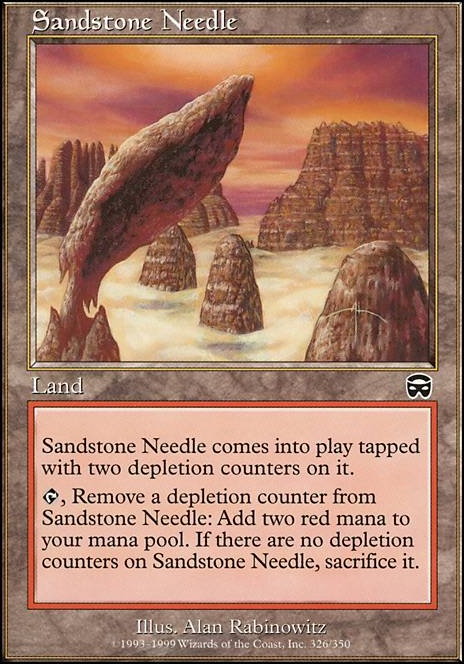
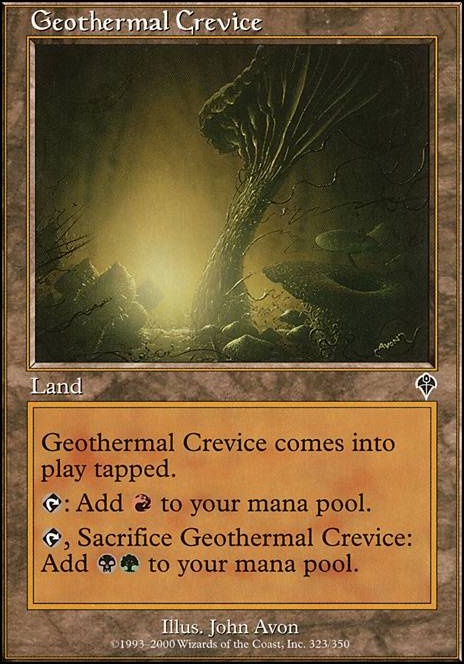
Something to note, the only other lands in pauper that can add two mana at a time are the unsustainable Depletion Cycle and the Three-Colored Sac-Lands from Invasion. The Depletion lands can only be used twice before they are lost, with no option to only add a single mana. The Invasion Sac' lands, however, can be kept around, tapping for a single color until needed, when they can be sacrificed and add two different colors of mana to your mana pool.
So, just for fun, let's look at the ramifications of playing a bounceland versus playing a depletion land. Playing the bounceland isn't possible on turn one, so your second turn is going to suffer in terms of mana curve if this in your opening hand. Also, despite it tapping for , it doesn't actually put you ahead in your mana pool. Even if you played a bounceland turn 2, on turn 3 you can still only generate a total of from lands. That's the same as if you played a basic land on each of you first three turns. But, what if you play another bounceland on Turn Three?
- T1: play Mountain (available mana: )
- T2: play Gruul Turf (available mana: )
- T3: re-play Mountain (available mana: )
- T4: play Gruul Turf (available mana: ) OR play Mountain (available mana: )
- T5: re-play Mountain (available mana: )
On the other hand, if you don't have a T3 land-drop in your hand, then you are probably running a very land-light deck. In which case, you cannot rely on your draw for a much-needed land, therefore you can utilize the bounceland on turn 2 to ensure your land-drop on turn 3. You might think, "why bother? The land is already on the battlefield, why even bother picking it up and putting it back down?" But it's because you want to use your lands to maximum efficiency each turn. If you are in this scenario, you presumably built your deck to cope with the loss of momentum on turn 2 by playing a -drop that is highly efficient in your deck. In such a case, you are now prepared to return to curve on turn 3, and either cast a -drop, or some combination of cards that equals , before the end of your opponent's turn.
Instead of accelerating your mana pool, instead what you have done is remained on-curve for the mid-game despite a lack of lands, either in-hand, or drawn into. The price you have payed is a hiccup, a dip on your mana curve on turn 2, but on turn 3 you are back to full capacity, and can now capitalize off of the fact there are less lands and more spells in your deck than is traditionally expected.
Meanwhile, playing the depletion land is possible Turn One, meaning Turn Two you can do something meaningful--like cast a -drop creature or cast an impactful -drop (Delver of Secrets Flip, Goblin Cohort, Charging Badger, etc) with a T2 basic land and hold mana up for a counterspell like Mana Leak or, um, what's that other one? Rhymes with Shmounterspell? I forget. On turn two your mana pool is accelerated. Your lands are generating more mana than they normally would if were only playing a basic land each turn. HOWEVER, this bliss will not last forever. You can accelerate your mana pool twice and that's it, then the land is gone forever. Then you truly are set back in land count and mana pool. Crack your depletion land on turns 2 and 3 and you lose it, then on turns 4 and 5 you better have some more good and drops, because you are now actually one land behind.
- T1: play Saprazzan Skerry (available mana: )
- T2: play Island (available mana: )
- T3: play Saprazzan Skerry (available mana: ) OR play Island (available mana: )
- T4: play Island (available mana: )
- T5: play land (available mana: )
You probably should have a -drop or more to cast on turns 2 and 3, also, because tapping a depletion land and using only from it hurts in more ways than one. Trust me. It makes you feel like an idiot, all up behind your face area. Seriously though, what you have done here is accelerated your mana pool in the early-game to where it would be during turns 4 and 5 normally. On turns 2 and 3, you can cast the same level of creature as you can on turns 4 and 5. This screws up your mana curve, but again, you have presumably prepared for this ahead of time, therefore your deck is designed to power out some early and -drops that set-up more and -drops. Those more and -drops, the second set, will be your win conditions--the cards that capitalize off of the previous set you played in earlier turns. Ideally, of course.
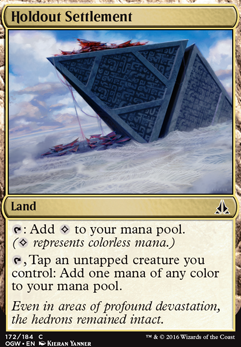
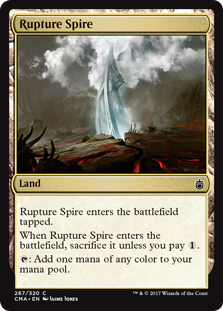
Coming up straight ahead of us are the Planes of Zendikar and Amonkhet, where we'll find Holdout Settlement and Survivors' Encampment, respectively. I Highlighted these guys in Issue #2 because as "budget" versions of spring leaf drum, I just think they're cool. They don't require mana to put in play... or elves to activate, which is nice. Decks that require a lot of "speed" to win might find these lands a too slow, and I doubt they'll ever make it to competitive play, but in the right deck they can make splashing up to five colors pretty easy. If you got a creature in your deck that you don't attack with, like Soul Warden, or just have an excess of chumps, or even a defender if your timing is good, you might be able to take advantage of these lands.
Now on to Alara's Rupture Spire and Ravnica's Transguild Promenade, which also seem interesting to me, like they could be pretty good in certain midrange decks. I tried them a couple times in some decks, and they are very slow, as they set you back two mana on the turn you play them. Rupture Spire/Transguild Promenade itself enters tapped, so you no longer have access to the mana from your land play. Additionally, you have to pay from a land/resource you've previously played just to keep it on the field. So if you play Transguild Promenade on Turn 2, you get no mana for that turn. However, on Turn 3 you'll be able to cast almost any 3-drop in pauper, even if your other two lands are Wastes. Can your deck wait that long? Is your T1 one-drop really that awesome? Possibly. Or maybe don't include a playset, just 2 or 3-of, so that you will be more likely to not have them in your opening hand. That way you can build a board presence and make yourself relatively safe before you play your costly Transguild Promenade. Again, they'll probably never make it to competitive play, but that never stopped me before.
Now, we make our way back home, but on the way we have some pamphlets for you to look at in case you still feel like sight-seeing. Exotic locations like Radiant Fountain, a lifeland for mono-colored decks; Quicksand, which you can sac' before blockers are declared to easily take care of most threats in pauper, or at least weaken it enough to bring it within range of one of your own blocker's power. There's also Bojuka Bog, often mainboarded as a one-of in mono-black decks because it hoses graveyard-based strategies. Haunted Fengraf can reanimate creatures at random, but if you activate when there's only one creature in your graveyard, or if you just want to get some sac-fodder back.... I've mentioned Sejiri Steppe and Sandstone Bridge before because they're awesome, but both Zendikar blocks provided us with great mono-color utility lands, like Looming Spires and Halimar Depths. Lands like Painted Bluffs, Shimmering Grotto and Unknown Shores can all filter mana into the color you need. And Cradle of the Accursed and Khalni Garden can help with token/weenies decks. The more adventurous or creative types will find a whole bunch of other options in Snips500's list below.
And that concludes our broadcast day, ladies and gentlemen. As always feel free to respond in the comments below to anything discussed in the article above, especially if you feel I might have missed something important, or gotten something wrong. Or if you just have something you want to contribute. Remember, my main goal is to create good, productive discussions about pauper, so don't hold back. Questions are always welcome also, because you just don't know until you ask.
I have some questions for you all, as well, of course. I tried to not just discuss staples, but a bunch of interesting lands. That being said, which non-basic lands do you use in pauper? Any favorites? Any you think are complete garbage? In either case, why? Does anybody have an opinion on Holdout Settlement, or Rupture Spire? Are they viable in pauper, in your opinion? What about Ash Barrens? Has anybody had any negative experiences with this card?
Now I'll leave you with the traditional Pauper Highlights, and until next time, stay safe everybody!
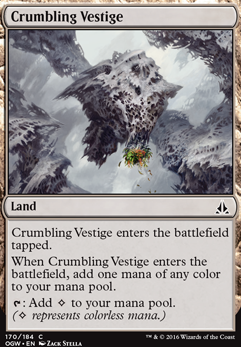
Here's another card that doesn't see much play that I just simply like. I can't see this being used in a deck that casts a lot of and -drops, but maybe in a two or three-color deck that tries to stay on curve and cast something big for the win mid-game, maybe? I have a casual Matca Rioters deck that I use Nylea's Presence in. I'm thinking maybe this would be a good fit there. Tell me what you think about this card and if you ever tried to use it, and how that went for you. I'd love to here some success stories involving it.
Exhuming End
Pauper
SCORE: 39 | 21 COMMENTS | 6033 VIEWS | IN 24 FOLDERS
Here's a player who makes use of what non-basics they can in pauper. What we have here is a Jund (+) Reanimator deck that uses a bunch of big-bodied creatures with cheap Cycling costs, like Horror of the Broken Lands, and Exhume to "cheat" them onto the battlefield early.
What we are looking at today, however, is Srcsqwrn's land base. Note that since the deck is mostly and , the builder included a couple Barren Moors and Tranquil Thickets, but no Smoldering Craters. Also, they apparently wanted the "speed" of Cycling for one mana of a specific color, rather than the "ease" of Cycling for . This choice frees up that second mana to be used elsewhere. Meanwhile Ash Barrens was chosen to do the heavy-lifting in terms of land play-fixing, and a couple Jund Panoramas also for clean-up. Without true dual-lands and true fetches in pauper, land-based tech needs to be kept to a minimum most of the time, and this a good example of such.
Hopefully this inspires you to build/brew/tweak/adjust/fix something of your own! Enjoy!
deck-large:all-non-basic-lands-in-pauper
This list, created by Snips500 is a valuable resource that I personally use quite often. I like it because it's grouped by categories and the author does a good job at keeping it up to date after new sets are released. Here you can see the options a pauper player has when building a land base. There's all types of tricks you can experiment with for multi-color decks, as well as some great utility that you might not be aware of. The only things this list lacks, in fact, are the Commander/EDH-specific lands for Pauper EDH decks, and they are Command Tower, Opal Palace and Path of Ancestry. There, now you know about them, too.
Please enjoy Snips500's list, make sure to thank him for the effort and as always, happy brewing everybody!
GunPla
Pauper
SCORE: 22 | 8 COMMENTS | 3412 VIEWS | IN 12 FOLDERS
Here's a kind of fun Colorless Affinity variant I'm working on, and being colorless (and Vorthos) forced me to try new things besides the usual tech. First of all... yes. The Tron Lands would be better in this deck than what I have now; I could put in a few more big baddies and cast Scour from Existence more often, buuuuut... I don't own any. And it's not really my style to buy cards for casual deck.
Darksteel Citadel is an obvious choice here, and having Radiant Fountain and Glimmerpost is nice as a hedge against damage. I like Sunscorched Desert because it's free damage, but I'm just that type of guy. I'll be honest here though, this deck isn't great or anything, and in fact, this is one I could probably use a lot of help on. But, hey! Look at all those fancy non-basics I'm using. Thanks for checking it out!
Boza: ??? Is that your guess for the musical reference above? =)
March 17, 2018 3:27 p.m.
TheRedGoat says... #5
This was actually very informative. I've got pretty much all of those lands you've mentioned except the cycling and true utility ones, and even then that is only from me not trying to play Pauper on any competitive scale. I look forward to reading more like this (and I probably will even take building pauper seriously to boot).
March 21, 2018 11:54 a.m.
zephramtripp says... #6
I just wanted to say I love your subtitle, "Finding Common Ground." It just rang true for me on so many levels.
March 21, 2018 3:04 p.m.
TheRedGoat: Thanks, I appreciate that!
I don't play pauper competitively either, actually. Nor do I play online, where Pauper is actually from, but if you simply have somebody or somebodies to "play pauper" with, brewing and building in this format can be very rewarding. If for no other reason than there's so much unexplored territory left in pauper to mess around with.
Plus, no matter what, building a deck is always a form art, yo. Even in Pauper. =P
zephramtripp: Thanks, glad you liked it. I literally almost entitled this article "A Tour Through Every-Man's Land," like a reference to the ubiquitous "No-Man's Land" in many works of fiction. Thankfully, I didn't. XD


eyes2sky says... #1
It's all about the base, the mana-base, no basics!
March 15, 2018 12:16 p.m.